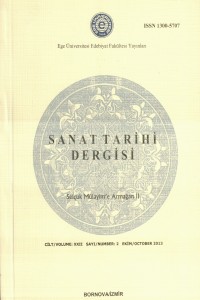Abstract
Since the beginnig of their existance, humans need to classify the objects and the assets in order to understand the environment that they are living in. The individual uses the distinctinve differences as a tool in the need of this classifying progress. The works of literature, painting, music, sculptor, theatre, movies and architecture are obtained as a result of individual progress of understanding the environment by classifying the distinctive differences. Among all these branches of arts architecture is painting a more gruelling field in this semantic construction activity. Because, architecture is not only visual, but also can be experienced physically. Above all, the work of architecture is a combine of different knowledge branches and this the makes work of architecture even more contradictory. In this study, there is a debate about how the work of architecture can be explained in the concept of beautiness and ugliness. The topic of this debate, use the frameworks of the questions as, how an architectural work can be accepted as beautiful or ugly, can we use the concept of definitions of the words ‘beauty’ or ‘ugly’ to define an architectural work, can ‘Basic Design Principles’ and ‘Gestalt Principles’ which are effective in creating an architectural work, be used to define the work as beautiful or ugly, or in another way of asking, can we make a normative comment as beautiful or ugly for an architectural work. In this binding , for the city of Trabzon, with the third grade students of architecture, a pilot study has been made with a subject named as ‘ugly constructions’ . The study contains the analyses and the results of the concept of theoretical definitions of ‘beautiness’ and ‘ugliness’ and the selection of beautiful and ugly buildings in Trabzon city by the group of students.
Keywords
References
- Aksoy, Ö. (1977), Biçimlendirme, Trabzon: KTÜ Yayınları.
- Aydınlı, S. (1993), Mimarlıkta Estetik Değerler, İstanbul: İTÜ MMF Baskı Atölyesi.
- Beşgen Gençosmanoğlu, A. (2001), Estetik ve Mimarlıkta Kavram, Kavramsal Analiz, Kavramlaştırma/1980 Sonrası Mimarlık Ürünleri Üzerine Örneklemeler, (Yayınlanmamış doktora tezi), KTÜ /Fen Bilimleri Enstitüsü, Trabzon
- Bodei, R. (2008), Güzelin Biçimleri, Ankara: Dost Kitabevi.
- Ching, F. (2002), Mimarlık, Biçim, Mekan ve Düzen, İstanbul: Yem Yayınları.
- Çolak, A. (2004), “Duvarlar: Anlamsal (semantik) ve Dizimsel (sentaktik) Bir Analiz”, (Yayınlanmamış Doktora Tezi), KTÜ /Fen Bilimleri Enstitüsü, Trabzon.
- Divanlıoğlu, H. (1997), Temel Tasar Tasarın Öğe ve İlkeleri, İstanbul: Birsen Yayınevi.
- Eco, U. (2009), Çirkinliğin Tarihi, İstanbul: Doğan Kitap.
- Güneş, A. (2011), “Yeni Eski Ustalarda Çirkinliğin Estetikleştirilmesi”, (Yayınlanmamış Yüksek Lisans Tezi), Mersin Üniversitesi/ Güzel Sanatlar Enstitüsü, Resim Ana Sanat Dalı, Mersin.
- Gürer, L. (1998), Temel Tasarım/Temel Eğitim, Yüksek Öğretimde Görsel Sanat Eğitimi Temel Tasarım Zorunluluğu, Ankara: ODTÜ Mimarlık Fakültesi Yayınları.
- Şentürer, A. (1995), Mimaride Estetik Olgusu, İstanbul: İTÜ Yayınları.
- Uraz, T., (1993), Tasarlama Düşünme Biçimlendirme, İstanbul: İTÜ Mimarlık Fakültesi Baskı Atölyesi.
Abstract
Toplumların, geçmişteki ekonomik, sosyal, kültürel, politik vb. özelliklerini yansıtan tarihi yapılar ve çevreler ait oldukları toplumların simgesel değerlerini de oluşturmaktadırlar. Geçmişi günümüze taşıyan bu eserlerin yok edilmesiyle sosyal ve kültürel değerlerin sürdürülebilirliği tehlikeye girmektedir. Oysa tarihi yapılar ve çevreler geçmişe referans olurken, günümüz kentlerinin algılanmaları ve okunabilirliklerini sağlayarak kullanıcıların yaşadıkları kentlere uyumlarına yardımcı olmaktadırlar. Çalışmada “kentlerin okunabilirliğini sağlayan özellikler, aynı zamanda yapıların da okunabilirliğini sağlayabilirler” savından yola çıkarak, Hollanda’nın Delft Kenti’nde bulunan Delft Teknik Üniversitesi’ndeki tarihi bir yapının mimarlık fakültesine dönüşüm sürecinde izlenen kentsel tasarım yaklaşımına bağlı olarak kentsel okunabilirliği araştırılıp bir kentin bir yapı içinde kurgulanabileceği ortaya konmuştur. Çalışma; işlevsel dönüşüm uygulanmış tarihi yapının, Kevin Lynch’in ortaya koyduğu bir kentin okunabilirliği için barındırması gereken kent imaj öğelerine bağlı olarak, analizini ve ortaya çıkan sonuçları içermektedir.
References
- Aksoy, Ö. (1977), Biçimlendirme, Trabzon: KTÜ Yayınları.
- Aydınlı, S. (1993), Mimarlıkta Estetik Değerler, İstanbul: İTÜ MMF Baskı Atölyesi.
- Beşgen Gençosmanoğlu, A. (2001), Estetik ve Mimarlıkta Kavram, Kavramsal Analiz, Kavramlaştırma/1980 Sonrası Mimarlık Ürünleri Üzerine Örneklemeler, (Yayınlanmamış doktora tezi), KTÜ /Fen Bilimleri Enstitüsü, Trabzon
- Bodei, R. (2008), Güzelin Biçimleri, Ankara: Dost Kitabevi.
- Ching, F. (2002), Mimarlık, Biçim, Mekan ve Düzen, İstanbul: Yem Yayınları.
- Çolak, A. (2004), “Duvarlar: Anlamsal (semantik) ve Dizimsel (sentaktik) Bir Analiz”, (Yayınlanmamış Doktora Tezi), KTÜ /Fen Bilimleri Enstitüsü, Trabzon.
- Divanlıoğlu, H. (1997), Temel Tasar Tasarın Öğe ve İlkeleri, İstanbul: Birsen Yayınevi.
- Eco, U. (2009), Çirkinliğin Tarihi, İstanbul: Doğan Kitap.
- Güneş, A. (2011), “Yeni Eski Ustalarda Çirkinliğin Estetikleştirilmesi”, (Yayınlanmamış Yüksek Lisans Tezi), Mersin Üniversitesi/ Güzel Sanatlar Enstitüsü, Resim Ana Sanat Dalı, Mersin.
- Gürer, L. (1998), Temel Tasarım/Temel Eğitim, Yüksek Öğretimde Görsel Sanat Eğitimi Temel Tasarım Zorunluluğu, Ankara: ODTÜ Mimarlık Fakültesi Yayınları.
- Şentürer, A. (1995), Mimaride Estetik Olgusu, İstanbul: İTÜ Yayınları.
- Uraz, T., (1993), Tasarlama Düşünme Biçimlendirme, İstanbul: İTÜ Mimarlık Fakültesi Baskı Atölyesi.
Details
| Primary Language | Turkish |
|---|---|
| Authors | |
| Publication Date | September 9, 2014 |
| Published in Issue | Year 2013 Volume: 22 Issue: 2 |

